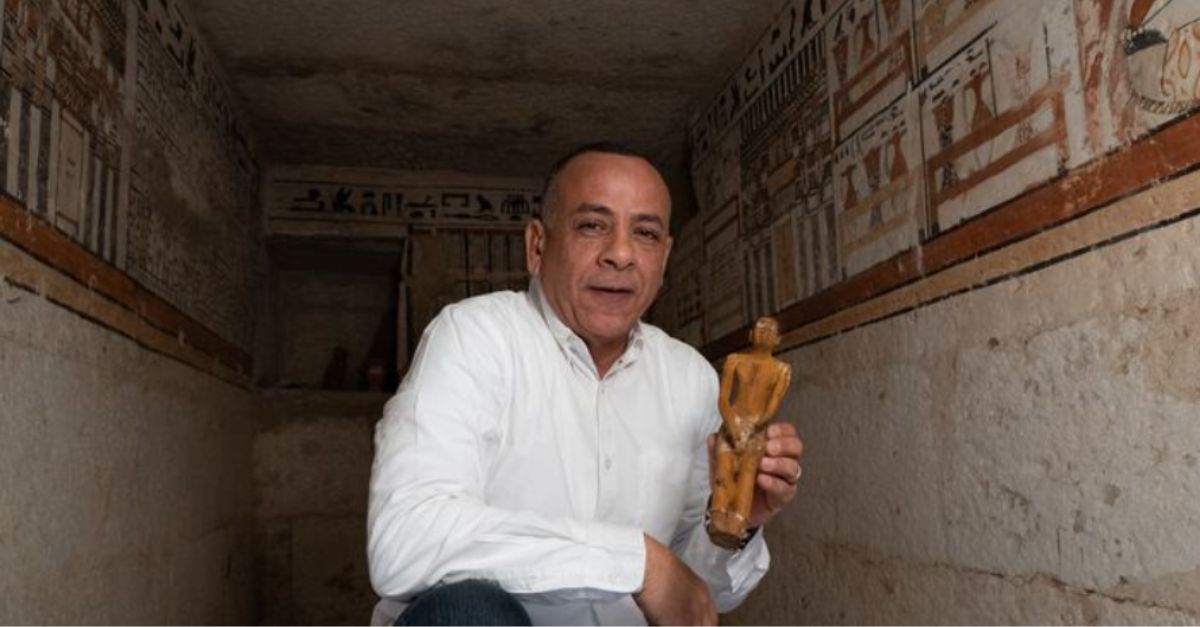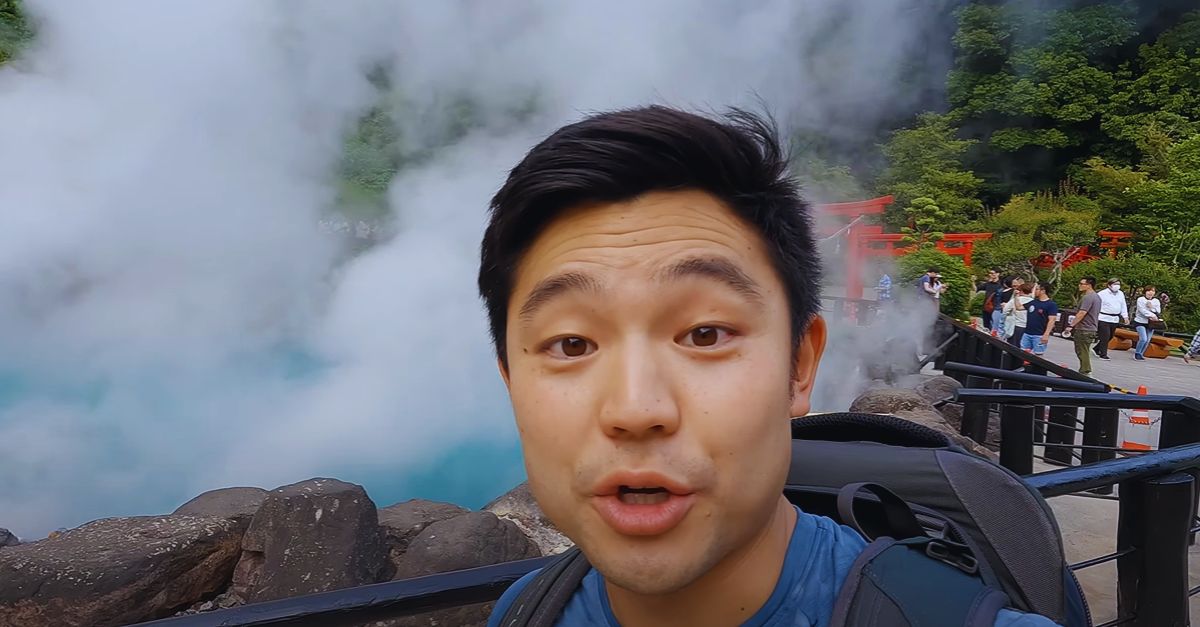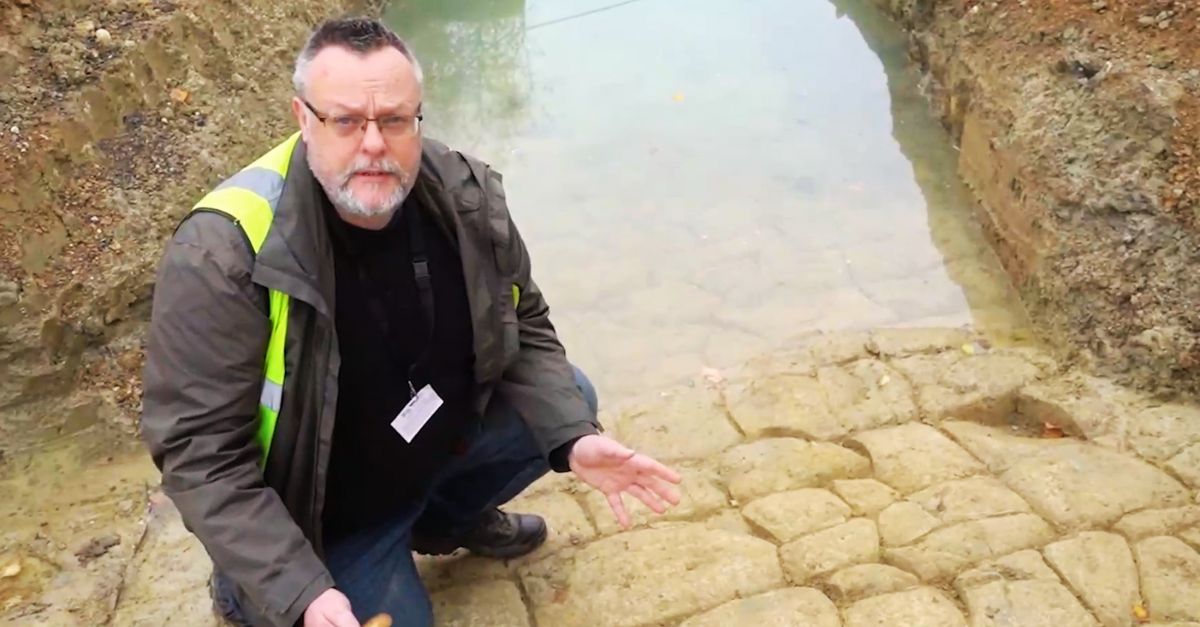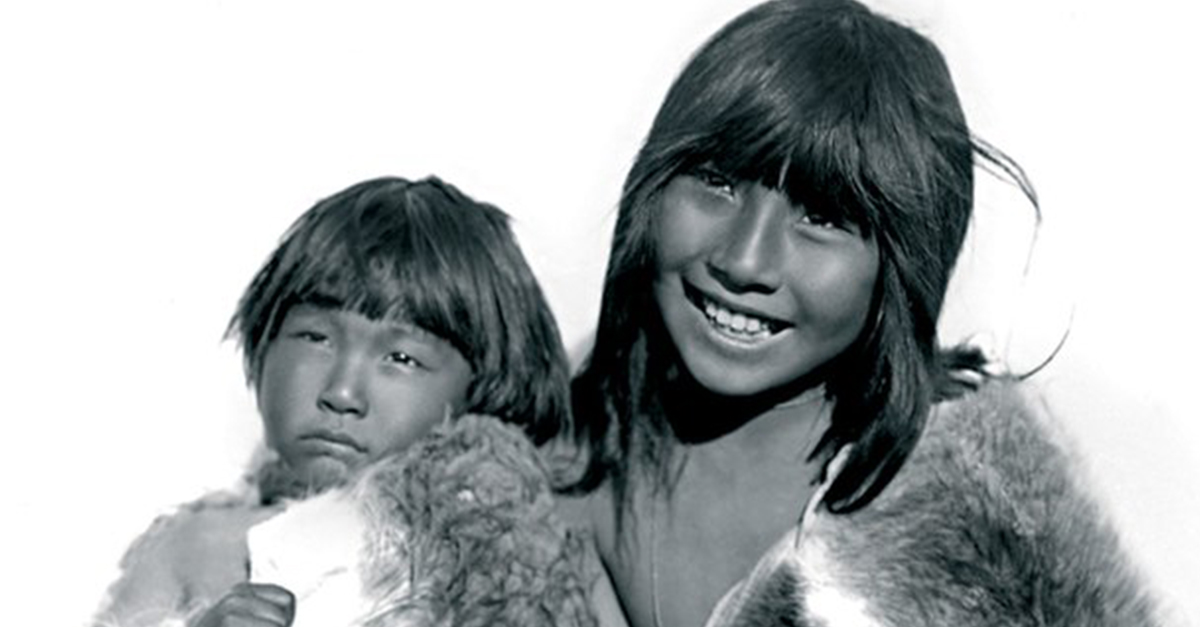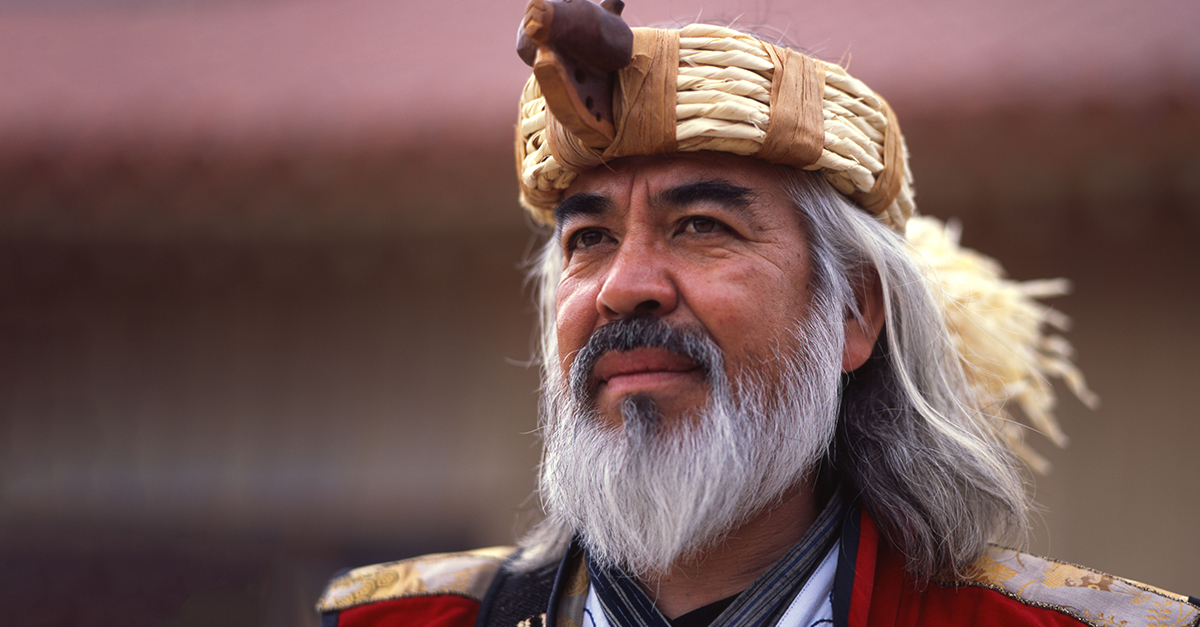Egypt’s Most Mysterious Physician
When archaeologists cracked open a sealed shaft in Saqqara, they didn’t expect to find a healer. They didn’t find a general or noble, but a man named Teti-Neb-Fu, a physician and magician.

A Hidden Tomb Stirs After 4,000 Years
Buried beneath Saqqara’s ancient dust, a tomb untouched for millennia has emerged into modern light. Belonging to Teti-Neb-Fu, this burial site connects us to a physician-magician who lived during Egypt’s Old Kingdom. Its preservation, despite looting, offers scholars fresh material to examine royal healthcare and sacred medicine.
 Vyacheslav Argenberg, Wikimedia Commons
Vyacheslav Argenberg, Wikimedia Commons
When The Earth Cracked Open In Saqqara
Archaeologists excavating Egypt’s oldest necropolis unearthed a sealed limestone shaft, which revealed finely preserved reliefs and painted stonework. This sudden exposure rewrote part of Saqqara’s story, revealing not a noble or soldier but a healer whose knowledge intertwined religion and protective incantations. The earth had yielded an extraordinary chapter.
A Name Resurfaces From A Lost World
Carved in hieroglyphs across a painted false door, the name “Teti-Neb-Fu” hadn’t been spoken aloud for 4,000 years. Egyptian belief held that speaking the name of the dead gave them eternal life. This rediscovery, therefore, is a cultural revival rooted in memory and spiritual continuity.
Who Was Teti-Neb-Fu?
Teti-Neb-Fu lived under Pharaoh Pepi II during a time when medical knowledge and religious rituals were deeply entwined. His tomb shows he held multiple roles: a physician, magician, dentist, and scholar. He was an elite functionary trusted with life and sacred temple knowledge.
 William Matthew Flinders Petrie (1853-1942), Wikimedia Commons
William Matthew Flinders Petrie (1853-1942), Wikimedia Commons
The Clues That Changed Everything
Inscriptions around the tomb detailed a job description. Titles such as “Overseer Of Healing Magicians” and “Master Of Medicinal Plants” reframed how historians understand healthcare in the Old Kingdom. This was no lowly doctor—Teti-Neb-Fu operated at the intersection of court and ritual authority.
 Charles J. Sharp, Wikimedia Commons
Charles J. Sharp, Wikimedia Commons
The Old Kingdom’s City Of The Dead
Saqqara, located just south of Cairo, served as the necropolis for Memphis, Egypt’s first capital. Active for more than 3,000 years, it houses the earliest pyramids and spiritual monuments. Discoveries here consistently highlighted the religious complexity and societal structure of ancient Egyptian civilization at its peak.
 Jon Bodsworth, Wikimedia Commons
Jon Bodsworth, Wikimedia Commons
Layers Of Time Beneath The Step Pyramid
Beneath Djoser’s Step Pyramid, the earliest colossal stone building in Egypt lies a labyrinth of tombs and corridors. Over centuries, layers of burials of royals and high priests accumulated. Teti-Neb-Fu’s tomb was interred among these levels, silently witnessing the dynastic rise and decline of one of history’s most enduring civilizations.
A Burial Ground Reserved For The Chosen
Only Egypt’s elite could secure burial at Saqqara. Tombs here often belonged to scribes, high officials, court magicians, and people entrusted with sacred duties and state secrets. Teti-Neb-Fu’s presence affirms his social standing and the prestige associated with medical authority, especially when woven with divine protection and spiritual responsibility.
 Decrypting the Secret Hieroglyphs: the Pyramid of Pepi II I SLICE HISTORY | FULL DOCUMENTARY by SLICE HistorySecrets Still Sleeping Under Stone
Decrypting the Secret Hieroglyphs: the Pyramid of Pepi II I SLICE HISTORY | FULL DOCUMENTARY by SLICE HistorySecrets Still Sleeping Under Stone
Saqqara’s buried chambers stretch across miles, with only a fraction fully excavated. Every opened tomb provides fresh insights into Egypt’s social order and intellectual culture. Teti-Neb-Fu’s burial hints that many more healers and spiritual leaders lie hidden—waiting to redefine how we view ancient science and spirituality.
 Decrypting the Secret Hieroglyphs: the Pyramid of Pepi II I SLICE HISTORY | FULL DOCUMENTARY by SLICE HistoryA New Chapter In Saqqara’s Long Story
Decrypting the Secret Hieroglyphs: the Pyramid of Pepi II I SLICE HISTORY | FULL DOCUMENTARY by SLICE HistoryA New Chapter In Saqqara’s Long Story
This tomb adds depth to Saqqara’s historical narrative. While the site is famed for pyramid construction and high-ranking officials, this finding underscores the respect afforded to medical specialists. It also reveals how religion and healing coexisted by giving a new dimension to the multifaceted roles preserved in Egypt’s most iconic necropolis.
 Magic Doctor Tomb Discovered in 2025 | Teti Neb Fu #ancienthistory #egypt #history by The Historical CodexPhysician To Pharaoh Pepi II
Magic Doctor Tomb Discovered in 2025 | Teti Neb Fu #ancienthistory #egypt #history by The Historical CodexPhysician To Pharaoh Pepi II
Serving the longest-reigning monarch in history, Teti-Neb-Fu practiced medicine during a time of both political longevity and creeping instability. As a royal physician, he likely oversaw treatments within the palace and temples. His proximity to the pharaoh suggests deep trust and a critical role in maintaining royal continuity and ritual health.
Keeper Of The King’s Teeth
Dental health was critical in ancient Egypt due to the grain-based diet and sand in bread that wore down enamel. As “Chief Dentist,” Teti-Neb-Fu may have been responsible for managing dental pain and abscesses using herbal pastes and rudimentary tools. This reflects surprising specialization in early Egyptian healthcare systems. Magic Doctor Tomb Discovered in 2025 | Teti Neb Fu #ancienthistory #egypt #history by The Historical Codex
Magic Doctor Tomb Discovered in 2025 | Teti Neb Fu #ancienthistory #egypt #history by The Historical Codex
Director Of Life And Medicinal Lore
Teti-Neb-Fu’s titles link him to medicinal botany and temple pharmacology. Egypt’s physicians often relied on papyri that cataloged plant-based treatments. As a director, he likely supervised the preparation and distribution of remedies that probably contained opium, frankincense, and honey. They were used to treat infection and spiritual imbalance across the kingdom’s elite ranks.
Master Of Serket’s Healing Ways
Serket, the scorpion goddess, was revered for her power over venom and breath. Teti-Neb-Fu’s association with her suggests he specialized in treating stings and possibly respiratory conditions. His magical role may have included invoking Serket through rituals by merging protective incantations with treatment to ward off invisible and visible dangers.
 Unknown authorUnknown author, Wikimedia Commons
Unknown authorUnknown author, Wikimedia Commons
A Man Trusted With More Than Bodies
Teti-Neb-Fu’s role extended to spiritual safeguarding and the management of sacred medical knowledge. This trust likely required initiations within priesthood orders and mastery of texts stored in temple libraries. These were only accessible to those with both education and proven loyalty.
Healing In A World Of Gods And Magic
Ancient Egyptian medicine fused science with spiritual belief. Diseases were often interpreted as divine punishment or spiritual imbalance. Healers like Teti-Neb-Fu combined diagnostics with magical rites by using amulets and offerings. His profession required balancing empirical plant knowledge with sacred chants believed to drive away illness-causing entities and curses.
Medicine As Ritual, Not Routine
Egyptian healing was a sacred performance. Diagnosing illness meant identifying not just physical symptoms but cosmic disharmony. Teti-Neb-Fu likely operated within temple-sanctioned spaces where rituals invoked deities and restored spiritual alignment. His treatments reflected a worldview where illness threatened the body and cosmic order.
Serket And The Power Over Poison
Scorpions and venomous snakes haunted daily life along the Nile. Serket, a goddess often depicted with a scorpion on her crown, represented protection against deadly stings. By aligning with Serket, Teti-Neb-Fu became a conduit of divine immunity.
 User:MatthiasKabel, Wikimedia Commons
User:MatthiasKabel, Wikimedia Commons
Words That Warded Off Evil
In ancient Egypt, words held power equal to action. Medical papyri contained incantations to accompany procedures believed to activate healing forces. Teti-Neb-Fu would have memorized these verbal formulas for protection and banishment of disease. For Egyptians, healing unspoken was healing undone, and words were instruments as vital as herbs.
Temples, Spells, And Sacred Remedies
The temples functioned as Egypt’s early hospitals and pharmacies. Inside, sacred scrolls documented remedies derived from myrrh, garlic, onions, and juniper—prescribed alongside spells and rituals. As a temple-affiliated physician, Teti-Neb-Fu likely curated this medicinal knowledge by blending observable effects with divine narratives to achieve healing that satisfied both the body and soul.
A Painted Doorway To The Afterlife
The red-painted “false door” in Teti-Neb-Fu’s tomb was symbolic architecture. Egyptians believed it was a threshold between worlds through which the spirit could receive offerings. Its vivid hue is traditionally tied to protection and vitality. It suggested that even in death, this healer’s work and memory were meant to continue.
The Language Of Symbols And Offerings
The tomb walls surrounding Teti-Neb-Fu’s resting place depict offerings of bread, beer, oxen, and incense—each symbolically loaded. These were insurance policies for eternal sustenance. The carvings serve as contracts between the deceased and the living world, ensuring the healer would never hunger or be forgotten.
Portrait Of A Man Who Refused To Fade
Carved figures of Teti-Neb-Fu show him receiving offerings and seated with dignity to immortalize his status. Unlike nameless workers, his image and legacy were preserved with care. Ancient Egyptians believed visibility in death maintained a presence in the afterlife. His tomb is a declaration: this man’s name and deeds will endure.
Even The Looters Left A Story
Though disturbed in antiquity, Teti-Neb-Fu’s tomb retains critical reliefs and architectural layout. The damage itself tells a story of economic shifts and changing burial security. Archaeologists piece together these clues not just to restore a tomb’s history but to chart centuries of cultural transformation and resilience.
Why This Burial Wasn’t Just For Rest
Teti-Neb-Fu’s tomb was a sacred engine designed to support his afterlife. Every wall inscription and offering scene served a ritual function. Ancient Egyptians viewed death as a continuation, not an end. This burial shows careful preparation for eternal influence and recognition.
 Yair Haklai, Wikimedia Commons
Yair Haklai, Wikimedia Commons
Life Under Pepi II’s Reign
Pepi II’s reign lasted over 90 years, outliving many advisors and possibly weakening centralized control. Yet, during its height, Egypt’s bureaucracy was efficient and expansive. Teti-Neb-Fu’s professional rise reflects a period when education and specialized skills could earn access to royal circles, even amid a slowly unraveling empire.
 Egyptian Pharoah Pepi II Coated His Slaves in Honey to Use as Fly Traps by Did You Know Discovery
Egyptian Pharoah Pepi II Coated His Slaves in Honey to Use as Fly Traps by Did You Know Discovery
What It Meant To Be Elite In The Old Kingdom
Elite status provided access to sacred spaces and eternal remembrance. Tomb inscriptions served as resumes for the afterlife. Teti-Neb-Fu’s inclusion in Saqqara’s inner tier affirms his prominence in both statecraft and temple society, a rare convergence in a highly stratified civilization.
 Egyptian Pharoah Pepi II Coated His Slaves in Honey to Use as Fly Traps by Did You Know Discovery
Egyptian Pharoah Pepi II Coated His Slaves in Honey to Use as Fly Traps by Did You Know Discovery
The Overlap Between Priesthood And Medicine
Egyptian doctors often served as priests, especially in temples devoted to healing deities. Their authority came not only from observation and treatment but from spiritual knowledge. Teti-Neb-Fu likely trained in both priestly rites and medical texts. This granted him social legitimacy as someone who healed under divine instruction, not personal ambition.
 HISTORY NEWS! Mar. 1st 25' Secrets of Teti Neb Fu Egypt's Ancient Healer by LookIntoHistory
HISTORY NEWS! Mar. 1st 25' Secrets of Teti Neb Fu Egypt's Ancient Healer by LookIntoHistory
Education In The House Of Life
The “House of Life” was the intellectual heart of temple complexes—a repository of medical and astronomical texts. Teti-Neb-Fu’s role as a “Magician of the House of Life” suggests he trained here. As a result, he gained access to sacred scrolls and elite instruction unavailable to most, which secured his authority as both healer and scholar.
 Unknown scribe, Wikimedia Commons
Unknown scribe, Wikimedia Commons
Sacred Texts And The Transmission Of Power
Power in ancient Egypt was textual. Knowledge passed through memorized hymns and inscriptions housed in temples. As a high-ranking healer, Teti-Neb-Fu helped preserve and possibly author formulas believed to cure or resurrect. These were acts of controlled sacred knowledge distribution.
 Diego Delso, Wikimedia Commons
Diego Delso, Wikimedia Commons
Egypt’s Place In Medical History
Egyptian medicine predates Hippocrates and Galen by over a millennium. Surgical instruments and detailed papyri like the Edwin Smith Papyrus show advanced understanding. Teti-Neb-Fu operated within this system and contributed to one of the earliest state-supported healthcare frameworks. He combined empirical treatment with theology in a structured, written tradition.
A Culture Where Disease Had A Soul
Illness in ancient Egypt could reflect divine disfavor or a spirit’s intrusion. Treatments required rebalancing internal forces and banishing unseen entities. Teti-Neb-Fu practiced medicine, incorporating cosmology and magic into his diagnoses before reaching a final conclusion. This reflected a cultural model that treated suffering as both medical and metaphysical disruption.
 The Tomb of Pharaoh’s Chief Dentist Discovered by NewEraNexus
The Tomb of Pharaoh’s Chief Dentist Discovered by NewEraNexus
How Egyptian Medicine Stood Apart
While Mesopotamian and Greek healers leaned heavily on astrology or philosophy, Egyptian medicine combined practical remedies with spiritual authority. Teti-Neb-Fu likely followed set diagnostic protocols using plant-based treatments and magical rites with surgical intervention. His work exemplifies a uniquely balanced system.
 Olaf Tausch, Wikimedia Commons
Olaf Tausch, Wikimedia Commons
Comparing The Magi-Healers Of Other Lands
Ancient healers existed across civilizations, but few carried dual roles like Egypt’s physician-priests. Unlike India’s Ayurvedic or China’s Taoist healers, Egyptian magi-doctors were state-integrated and often buried with honors. Teti-Neb-Fu’s burial highlights Egypt’s distinctive reverence for those who bridged healing and divine service within a centralized theocratic system.
A Legacy That Outlasted Empire
Egypt’s medical traditions influenced later Greek, Roman, and Islamic systems. Texts from temple libraries survived through translations and citations. Although Teti-Neb-Fu’s name faded for millennia, his ritual medicine, backed by organized knowledge, laid the groundwork for global medical evolution. It proved that intellectual legacies often endure beyond political collapse.
 Dennis G. Jarvis, Wikimedia Commons
Dennis G. Jarvis, Wikimedia Commons
Why Teti-Neb-Fu Still Echoes Through Time
Beyond titles, Teti-Neb-Fu represents a rare synthesis of science and spirituality. His rediscovered tomb offers insight into how knowledge, belief, and power intersected. He symbolizes a moment when healing was sacred, medicine was elite, and the boundary between doctor and divine messenger was not only blurred—but institutionalized.
 The Tomb of Pharaoh’s Chief Dentist Discovered by NewEraNexus
The Tomb of Pharaoh’s Chief Dentist Discovered by NewEraNexus
The Tomb That Rewrote Old Assumptions
This find challenged assumptions that Old Kingdom medicine was undocumented or informal. The titles and inscriptions proved otherwise. Teti-Neb-Fu’s burial confirms that structured healthcare roles and professional status were not late developments. They were core features of Egypt’s bureaucracy even before the great pyramids fell silent.
 HISTORY NEWS! Mar. 1st 25' Secrets of Teti Neb Fu Egypt's Ancient Healer by LookIntoHistory
HISTORY NEWS! Mar. 1st 25' Secrets of Teti Neb Fu Egypt's Ancient Healer by LookIntoHistory
What Scholars See In Every Brushstroke
Every painted glyph and carved detail carries weight. Scholars analyze pigment composition and hieroglyphic phrasing to determine ritual purpose and social rank. Teti-Neb-Fu’s tomb offers a near-complete cultural dossier by turning art into evidence and iconography into biography.
 HISTORY NEWS! Mar. 1st 25' Secrets of Teti Neb Fu Egypt's Ancient Healer by LookIntoHistory
HISTORY NEWS! Mar. 1st 25' Secrets of Teti Neb Fu Egypt's Ancient Healer by LookIntoHistory
A Civilization That Understood Balance
Ancient Egyptian thought revolved around ma’at—the principle of cosmic order. Medicine reflected that ideal: balance in the body mirrored balance in the universe. Teti-Neb-Fu’s roles were symbolic acts meant to restore harmony. His profession was a ritual of equilibrium and not merely treatment or technical repair.
 HISTORY NEWS! Mar. 1st 25' Secrets of Teti Neb Fu Egypt's Ancient Healer by LookIntoHistory
HISTORY NEWS! Mar. 1st 25' Secrets of Teti Neb Fu Egypt's Ancient Healer by LookIntoHistory
Medicine Before Microscopes
Without modern instruments, Egyptian physicians relied on sensory observation and detailed herbal knowledge. They recognized pulse, inflammation, infection signs, and the need for cleanliness. Teti-Neb-Fu’s medical practice predated microscopes by thousands of years, yet his healing likely saved lives using systematic knowledge passed through sacred oral tradition.
A Symbol Of Wisdom
Teti-Neb-Fu represented Egypt’s holistic ideal of knowledge in service to life and order. His preserved identity affirms the societal value placed on intellect and healing. Through him, we see that wisdom was practiced and rewarded with eternal remembrance.
 HISTORY NEWS! Mar. 1st 25' Secrets of Teti Neb Fu Egypt's Ancient Healer by LookIntoHistory
HISTORY NEWS! Mar. 1st 25' Secrets of Teti Neb Fu Egypt's Ancient Healer by LookIntoHistory
When Tombs Teach The Living
Every artifact from Teti-Neb-Fu’s tomb serves as a lesson. His life story, preserved in stone, offers insights into science and spiritual health. The messages left behind were designed to teach generations. His burial is an enduring textbook carved into limestone.
 HISTORY NEWS! Mar. 1st 25' Secrets of Teti Neb Fu Egypt's Ancient Healer by LookIntoHistory
HISTORY NEWS! Mar. 1st 25' Secrets of Teti Neb Fu Egypt's Ancient Healer by LookIntoHistory
The Gaps That Still Remain
Despite rich detail, questions linger. What treatments did he pioneer? Did his lineage continue his work? How widespread was his influence? The tomb provides structure but not the full story. Each missing scroll or broken relief reminds us that archaeology uncovers outlines—never full biographies of the lives buried beneath the sands.
A Magician Who Finally Got Our Attention
For centuries, Teti-Neb-Fu lay forgotten. Today, he reenters global conversation as a documented figure of science and spirit. His rediscovery reclaims the visibility of ancient healers by placing them alongside kings. At last, the magician-physician of Saqqara has the audience he was always meant to reach.
 HISTORY NEWS! Mar. 1st 25' Secrets of Teti Neb Fu Egypt's Ancient Healer by LookIntoHistory
HISTORY NEWS! Mar. 1st 25' Secrets of Teti Neb Fu Egypt's Ancient Healer by LookIntoHistory

